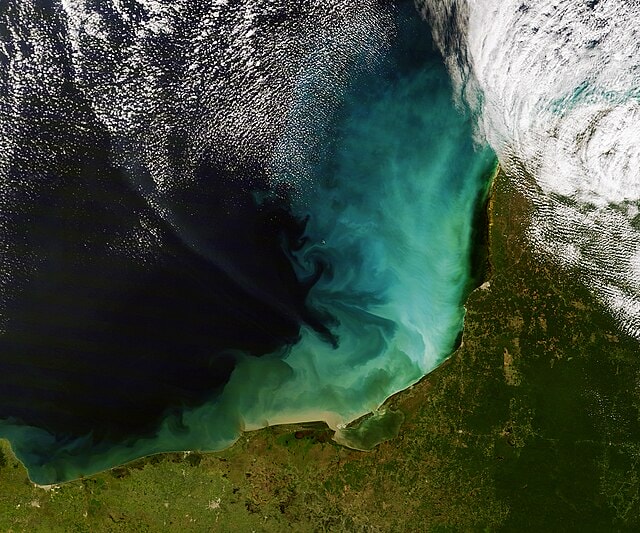A new investigation by the Guardian has found that almost everywhere in Europe, air pollution levels are higher than the World Health Organization’s recommended limits — 98% of Europeans are breathing unhealthy air.
The analysis — part of the EU-funded Expanse project to improve people’s health in urban environments by 2030 — was possible thanks to satellite images and measurements from more than 1,400 monitoring stations.
The Guardian has created an interactive map showing European air quality. Eastern Europe and Northern Italy are the most polluted regions.
Among Eastern European countries, North Macedonia is the worst-hit one, with more than two-thirds of residents living in areas with air quality four times more polluted than the recommended limits. Four areas, including its capital, Skopje, have air pollution almost six times the limit.
Half of the Serbian population likewise lives in areas where air pollution is four times the WHO’s recommended limit. Almost all residents of Slovakia, Albania, Romania, Poland, North Macedonia, and Hungary also breathe air that’s double the suggested limit.
In Western Europe, Italy — especially the Po Valley area — is the worst-hit country. In Northern Italy, almost one-third of inhabitants breathe air four times more polluted than the limit.
The amount of Western Europeans living in areas with double the recommended pollution levels is high in many other countries: 75% in Germany, 49% in Spain, and 37% in France.
By contrast, some areas in northern Scotland fall below the recommended limit, while nowhere in Sweden do PM2.5 levels exceed double the limit.
‘Impossible to live’: Italy’s Po Valley blighted air among worst in Europe https://t.co/yUQ49XKD0D
— The Guardian (@guardian) September 21, 2023
Around 30 million Europeans live in places “with small particle concentrations that are at least four times the WHO guidelines.”
Roel Vermeulen, the Utrecht University professor who led the research, stated that this “is a severe public health crisis.” According to the Guardian’s investigation, only 2% of European countries are within this limit.
“What we see quite clearly is that nearly everyone in Europe is breathing unhealthy air,” Professor Vermeulen added.
With 400,000 deaths every year in Europe linked to air pollution, improving the situation is fundamental.
The Consequences of Air Pollution
The WHO defines air pollution as the “contamination of the indoor or outdoor environment by any chemical, physical or biological agent that modifies the natural characteristics of the atmosphere.”
Cooking, heating, vehicles, power generation, agriculture/waste incineration, and industry are the major contributors to air pollution.
Air quality is strictly linked to health. Exposure to toxic air can cause, among others, strokes, heart diseases, lung cancer, and acute and chronic respiratory diseases.
Related articles: Why the EU Parliament Vote on Cleaner Air Rules Is Not Enough | Air Pollution is Leading Environmental Killer, Claiming 7 Million Lives | Air Pollution in Europe: Exposure Kills 1,200 Children Every Year
A first-of-its-kind global study — published in November 2022 in Nature Communications — found that almost one million stillbirths a year can be attributed to air pollution.
Air pollution is also “an issue of environmental injustice,” since research has shown that air pollution affects poorer communities the most.
Barbara Hoffmann, professor of environmental epidemiology at the University of Düsseldorf, said that “cleaning up the air specifically in eastern Europe is urgently needed to provide equal opportunities for a healthy life across Europe.”
Air Quality Standards: WHO Guidelines
Scholars at the Swiss Tropical and Public Health Institute and Utrecht University grouped the data and information about land use to calculate the average micrograms of PM2.5 per cubic metre between 2000 and 2019.
Fine particulate matter (PM2.5) are “particles with an aerodynamic diameter of equal or less than 2.5” that can go inside the lungs and affect significant body parts.
The WHO guidelines recommend levels for the most common pollutants. For PM2.5, the recommended limit is 5 micrograms a cubic metre (µg/m3).

The European Union is taking action to improve air quality standards. Last week, the European Parliament agreed to set a legally binding limit of 5 µg/m3 for PM2.5 emissions. However, the goal will have to be achieved by 2035.
“This is great news for all European citizens,” said Zorana Jovanovic Andersen, chair of the European Respiratory Society’s environment and health committee. The vote represents “an important step in the right direction toward clean air for all, even though the full alignment with the WHO was moved from 2030 to 2035.”
This new resolution and the recent investigation prove extremely useful to inform about air pollution and its effects.
Dr Hanna Boogaard, an expert on European air pollution at the US Health Effects Institute, stated that the EU’s measure provided “a unique opportunity to be bold […] and maximise public health benefits for Europe and beyond.”
We just need politicians “to be bold and ambitious and take the necessary urgent steps to tackle this crisis,” Vermeulen said.
Editor’s Note: The opinions expressed here by the authors are their own, not those of Impakter.com — In the Featured Photo: Thick black smoke cloud spreading above the ground, due to atmospheric inversion conditions, Lille France, 2019. Featured Photo Credit: Lamiot.













